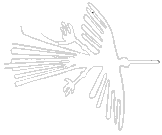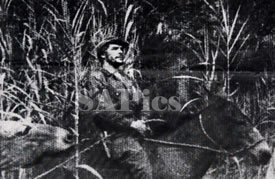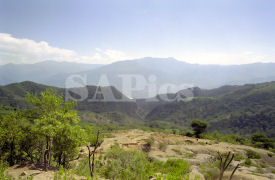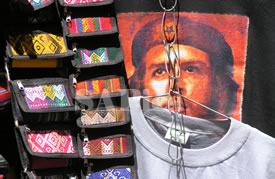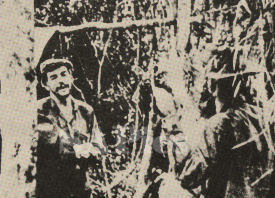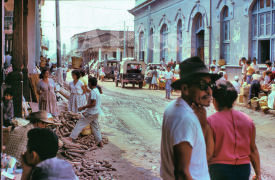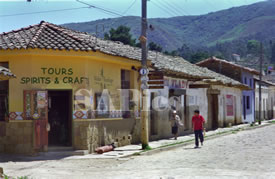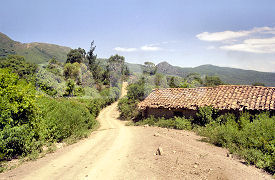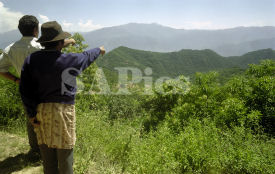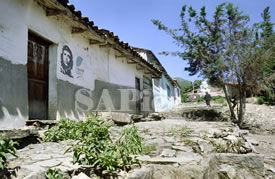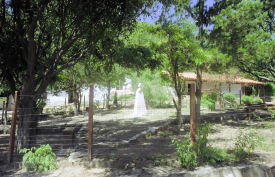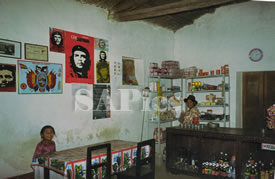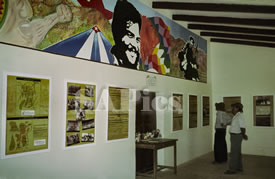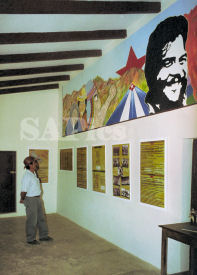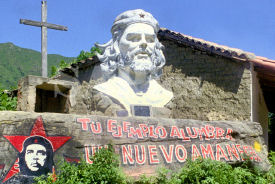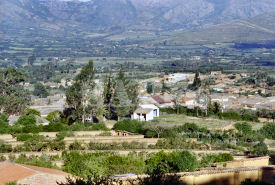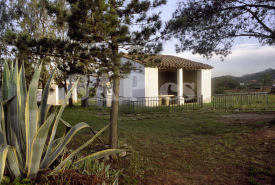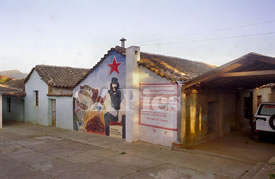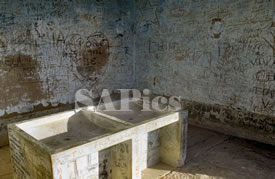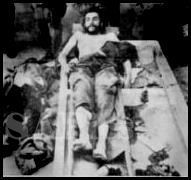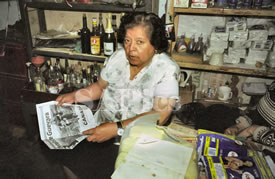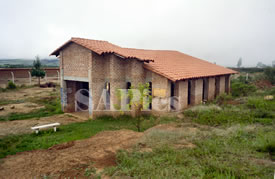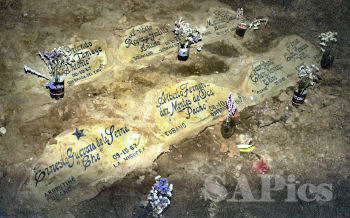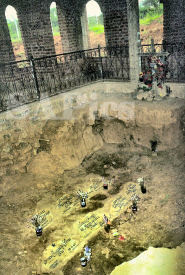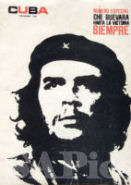| Colour
photographs of the route by the late Steve Harrison |
| |
|
| Santa
Cruz is now the largest city in Bolivia and one
of the fastest growing in South America. When Che Guevara passed this way secretly
in 1966, en route to La Paz the Bolivian capital, many of the streets close to
the centre were still unpaved and American made WW2 Willys Jeeps were common.
Santa Cruz is a good starting point for the Che Trail. | Samaipata
is a small town in the foothills of the Andes mountains, about 120 kms from Santa
Cruz. On 6 July 1967 the guerrillas attacked a small army post and took
ten prisoners. They captured some weapons and a truck. They left the prisoners
naked by the road about a kilometre from the town |
|
|
|
| The
road to La Higuera - the name comes from a type of fruit or 'fig'. It is a tiny
village near the spot where the Rio Grande - an Amazon tributary begins to leave
the Andes mountains | The
Bolivian army eventually cornered the band in a narrow canyon the Quebrada
de Yuro [also as Churo] pointed out by local woman. Che was
wounded and gave himself up. The spot is about 8kms from La Higuera |
| |
|
| La
Higuera survives on the legend of Che. It is still a quiet backwater where
life continues peacefully. | Back
in 1967 the Bolivian army took the wounded Che Guevara to the tiny schoolhouse
in La Higuera. A statue to the hero now stands outside |
|
|
|
| A
nearby shop is decorated with Che memorabilia and the owner holds the key to the
schoolhouse museum | The
schoolhouse has been transformed with funds from the United Kingdom [Reino
Unido] and FundeCHE* |
| |
|
| While
wounded and bound in the schoolhouse Che Guevara was shot in the chest several
times. He died in the schoolhouse and as a memorial a large moulded bust stands
on a rock outside. His body was strapped to the skids of an helicopter and flown
to Vallegrande a small town 34 kms away. Vallegrande is approximately 125
kms southeast of Santa Cruz |
| |
|
| The
corpse was moved to a small open air laundry - the white painted building - in
the grounds of the hospital of Our Lord of Malta, Vallegrande. |
The
laundry is now disused and maintained as part of the Ruta del Che |
| |
|
| A
commemorative plaque of ceramic tiles on the Hospital Señor de Malta, Vallegrande | The
hospital [Our Lord of Malta] Vallegrande. The name Malta originates from the 11th
century Knights of St John - The Knights Hospitalier of Jerusalem. After 1530
they were known as the Knights of Malta - as used in the Mediterranean island |
| |
|
| The
body of Che Guevara was laid across two shallow basins of the laundry and local
officials and then the Press were allowed to see the corpse. Many photographs
were taken some with members of the army alongside. The news quickly sped around
the world. But far from being the end of the affair Che Guevara became an even
greater hero and martyr for the cause of international revolution. |
| |  |
| Señora
Susana Osanaga who now owns a shop was a young nurse at the time. She was given
the job of washing the corpse before it was displayed in the laundry. | The
laundry is now a shrine and many visitors try to leave their mark, sometimes with
just a name and occasionally a sentiment or two by scratching the plaster wall |
| |
|
| | After
the Press had reported from Vallegrande the authorities decided not to bury Che
Guevara and others of the revolutionary group in the local cemetery.They were
afraid that it could become a place of pilgrimage for potential rebels so instead
they took the bodies to a corner of the airfield and buried them hastily. In 1997/1998
the Bolivian President was persuaded to disinter the remains and return those
of Che Guevara to Cuba. An impressive protective cover has since been built over
the site of the graves and visitors can see the pit where the bodies were found.
The spot marked for Che is at the bottom of the photograph. Others who were buried
here included 'Willy' Simon Cuba Sarabia who helped Che when he was wounded in
the Quebrada de Yuro. Others were Orlando Tamayo "Antonio'; Aniceto
Reynago Gordillo "Aniceto"; Rene Martinez Tamayo; Alberto Fernández
Moises de Oca "Pacho" and Juan Pablo Chang Navarro. |
| |
|
| In
Argentina 17th October 1967 the weekly magazine Siete Dias ran the story
with the title ' La Ultima Muerte del Che Guevara' - His last death. | In
Cuba dated November 1967 - a special commemorative book was published covering
the life of Che Guevara. His quote 'Hasta la victoria siempre' is prominent
on the cover. 'Until Victory, Always.' | |
| Far
from being dead and forgotten Che Guevara images spread around the world in their
millions. The most famous and now iconic phoptograph was taken in March 1960 by
Cuban photographer Alberto Díaz Gutiérrez known as Korda |
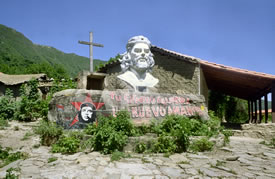 | 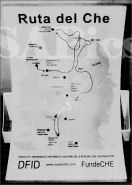 | 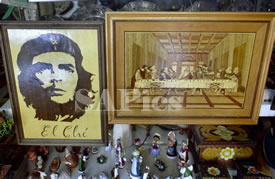 |
| *Funds
for the Ruta del Che were contributed by DFID the Department for International
Development [The British Government, London, England] and FundeCHE a foundation
created by the Emerging Markets Group-EMG [London,England, Brussels, Belgium and
Arlington,VA, USA]. The bust of Che in La Higuera stands on a rock beside a Cross
marking a holy place with the words painted below: 'Tu exemplo alumbrar.
Un nuevo amanacer - Your example lights the way. A New dawn. On the right
is some memorabilia from Santa Cruz. A painting of Che copied from the Korda image
and the iconic table of 'The Last Supper'. A curious twist to the story |
|
| Tony
and Marion Morrison were filming wildlife in Bolivia at the time of the death
of Ernesto 'Che' Guevara . The South American Pictures archive includes many references
to 'Che' including contemporary news items, images of his birthplace in Argentina,
memorials in Cuba and memorabilia from many countries. Special thanks are given
to the small museum in La Higuera. |
